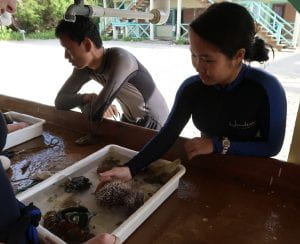No contacts, vision blurred, sea breeze swaying you from one direction to the other. The urge to pee taking over. Stumbling blindly around the trail to Clivus, the compostable toilet. Dodging huge, mango-sized blue land crabs, silently and fuzzily praying they don’t charge.
I’m wondering when I will have to face one of these blue crabs that rule the island by night. During the day, when they’re retreating back to their covers, they look too goofy to take seriously. They scuttle sideways, claws snapping open and shut, their tiny feet skittering across the ground. I hear Mr. Krabs whenever they walk. But in the night, they have the power to rob me of a finger or a toe.
It’s crazy the kind of stuff that gets washed up on islands, including these outlandish blue land crabs. We’re 34 miles away from the closest land-based town and 70 miles out from Belize City, yet, life finds a way. Dr. Solomon saw a hummingbird buzzing around yesterday, and it is more common than not to stumble upon a spiny-tailed iguana, hermit crab, or blue land crab. It turns out land hermit crabs first arrive from the mainland as eggs. The mothers release them into the sea, where they hatch and begin life as tiny, drifting larvae. After several molts and a search for their first shell, they make the critical journey to land.
(Hermit Crabbies – 05/26/25)
But the real reason we’re on this remote island is to be near Glover’s Reef, where we can explore marine biodiversity – not just island biogeography. Today, our mission was to trace the diet of parrotfish. We were investigating whether different species of parrotfish specialize in specific types of food, or if they’re generalist feeders that consume a broad range of items, including seagrass, algae, and coral. To study this, we conducted a fish follow survey, with each team tracking an individual parrotfish, observing its behavior to identify what it was eating. As Dr. Evans put it, now we’re doing “camera chases” instead of the “camera traps” we set up in the rainforest.
DSCF1655 (Stoplight Parrotfish Feeding on Algae – 05/24/25)
Sohee and I felt some residual sea sickness from the day before, so we decided to stay in the shallow area and survey the seagrass for redtail parrotfish, who are known to consume sea grass. While we could not find any parrotfish, we saw 2 needlefish near the surface by the dock, a couple of snappers, and a nurse shark. I didn’t spot any sponges in the shallow seagrass bed – probably because there were fewer hard surfaces for them to attach to, and the water flow was much less compared to the reef. Luckily, Dr. Solomon found us a sea cucumber, my new obsession. These guys are thick, shiny, squishy rods with several bumps along their bodies that serve as little feet. Some have commensal symbiotic relationships with pearlfish, who swim up their anus and use them as protection without giving the sponge much in exchange. I looked over, and Sadhana draped the sea cucumber over her forehead. She giggles and goes, “You know what they say, you are what you put on your head.”
DSCF1887 (Seagrass Snapper Spotting – 05/26/25)
Though the island life takes some adjustment, this tiny island is filled with and surrounded by so many ecological gifts, from intimidating land crabs to weird, cucumber invertebrates. After days of learning and getting our hands in the water, I adore relaxing with friends around the dock. We stare down at the ocean to watch creatures pass by underway or gaze up at the sky full of stars. With wind blowing our hair every which way, we breathe in the ocean life.
(Breathing in the Sea Breeze – 05/26/25)
Peace out,
Lily H. 🙂 2025





